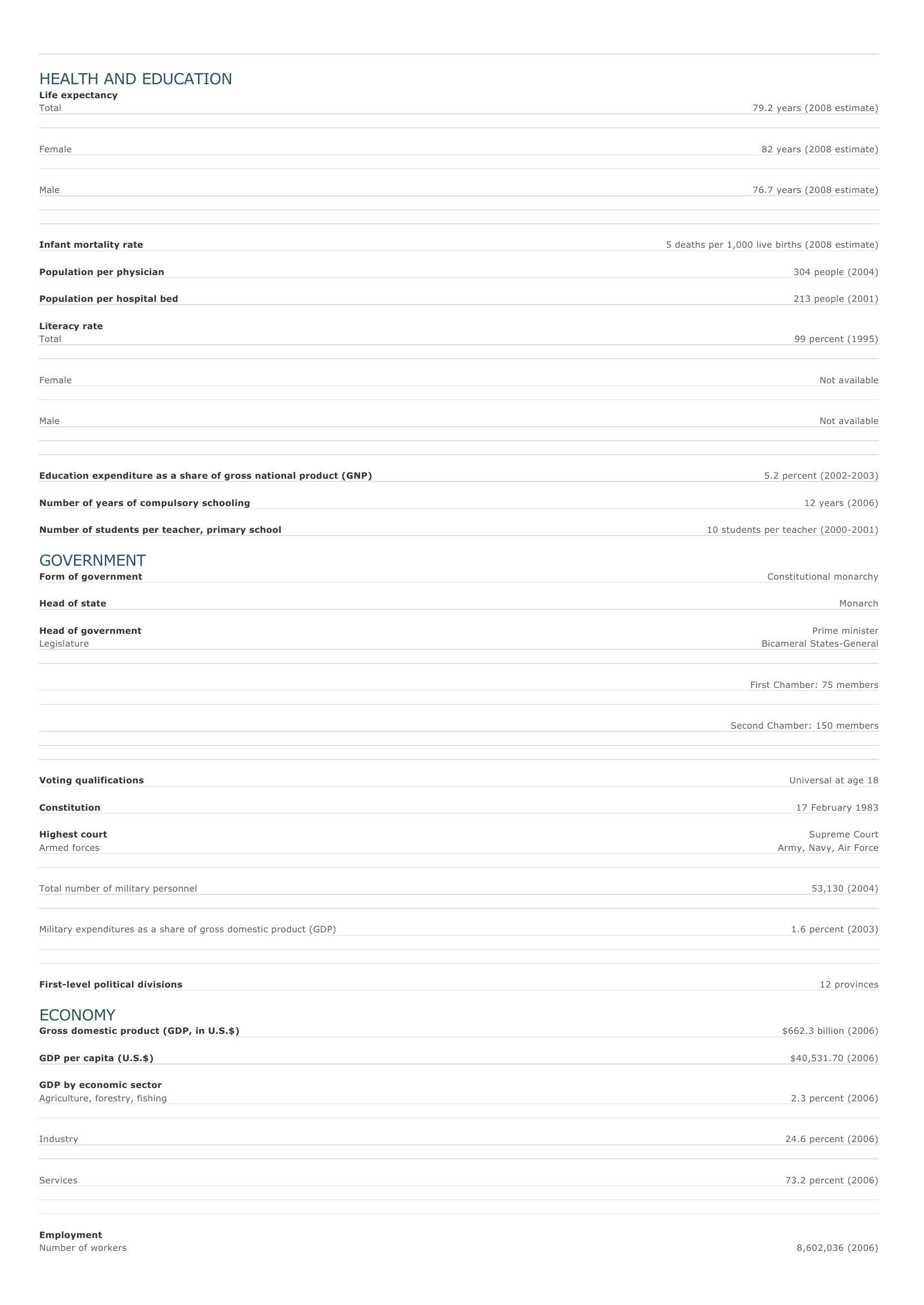The Netherlands Facts and Figures. BASIC FACTS Official name Kingdom of the Netherlands Capital Amsterdam; The Hague is the seat of government. Area 41,526 sq km 16,033 sq mi PEOPLE Population Population growth Population growth rate 16,645,313 (2008 estimate) 0.44 percent (2008 estimate) Projected population in 2025 17,539,636 (2025 estimate) Projected population in 2050 17,334,090 (2050 estimate) Population density 491 persons per sq km (2008 estimate) 1,272 persons per sq mi (2008 estimate) Urban/rural distribution Share urban 67 percent (2005 estimate) Share rural 33 percent (2005 estimate) Largest cities, with population Amsterdam 739,300 (2004 estimate) Rotterdam 596,100 (2004 estimate) The Hague 468,400 (2004 estimate) Utrecht 275,800 (2004 estimate) E indhoven 208,600 (2004 estimate) Ethnic groups Dutch Moroccan, Turkish, Indonesian, Surinamese, and other 96 percent 4 percent Languages Dutch (official), Frisian, Flemish, English, German, French Religious affiliations Roman Catholic 34 percent Protestant (largely Dutch Reformed Church and Calvinist) 27 percent Muslim 4 percent Atheist 1 percent Nonreligious 13 percent O ther 21 percent HEALTH AND EDUCATION Life expectancy Total Female Male Infant mortality rate 79.2 years (2008 estimate) 82 years (2008 estimate) 76.7 years (2008 estimate) 5 deaths per 1,000 live births (2008 estimate) Population per physician 304 people (2004) Population per hospital bed 213 people (2001) Literacy rate Total 99 percent (1995) Female Not available Male Not available Education expenditure as a share of gross national product (GNP) Number of years of compulsory schooling Number of students per teacher, primary school 5.2 percent (2002-2003) 12 years (2006) 10 students per teacher (2000-2001) GOVERNMENT Form of government Head of state Head of government Legislature Constitutional monarchy Monarch Prime minister Bicameral States-General First Chamber: 75 members Second Chamber: 150 members Voting qualifications Constitution Highest court Armed forces Total number of military personnel Military expenditures as a share of gross domestic product (GDP) First-level political divisions Universal at age 18 17 February 1983 Supreme Court Army, Navy, Air Force 53,130 (2004) 1.6 percent (2003) 12 provinces ECONOMY Gross domestic product (GDP, in U.S.$) $662.3 billion (2006) GDP per capita (U.S.$) $40,531.70 (2006) GDP by economic sector Agriculture, forestry, fishing 2.3 percent (2006) I ndustry 24.6 percent (2006) Services 73.2 percent (2006) Employment Number of workers 8,602,036 (2006) Workforce share of economic sector Agriculture, forestry, fishing 3 percent (2005) I ndustry 20 percent (2005) Services 73 percent (2005) Unemployment rate 4.3 percent (2003) National budget (U.S.$) Total revenue $279,158 million (2006) Total expenditure $274,797 million (2006) Monetary unit* 1 euro (EUR), consisting of 100 cents *The Netherlands guilder (f.) became linked to the EU single currency, the euro (EUR), on 1 January 1999 at a fixed rate of 2.20371 to 1 euro (EUR). Euro coins and bills replaced the Netherlands guilder as the national currency on January 1, 2002. Agriculture Potatoes, sugar beets, vegetables and fruits, wheat, other cereals; cut flowers and flower bulbs; dairy products Mining Natural gas, petroleum Manufacturing Food, beverage, and tobacco products; chemicals and chemical products; electronic equipment; machinery; transportation equipment; metal products; printed material Major exports Basic manufactures, food products, machinery, chemicals and chemical products, transportation equipment, petroleum products, natural gas Major imports Machinery, basic manufactures, food and live animals, chemicals, transportation equipment, petroleum and petroleum products Major trade partners for exports Germany, Belgium, United Kingdom, France, and Italy Major trade partners for imports Germany, United States, Belgium, United Kingdom, and France ENERGY, COMMUNICATIONS, AND TRANSPORTATION Electricity production Electricity from thermal sources 90.08 percent (2003 estimate) Electricity from hydroelectric sources 0.08 percent (2003 estimate) Electricity from nuclear sources 4.20 percent (2003 estimate) Electricity from geothermal, solar, and wind sources 5.65 percent (2003 estimate) Number of radios per 1,000 people 980 (1997) Number of telephones per 1,000 people 466 (2005) Number of televisions per 1,000 people 542 (2000 estimate) Number of Internet hosts per 10,000 people 2,163 (2003) Daily newspaper circulation per 1,000 people 305 (1996) Number of motor vehicles per 1,000 people 427 (1999) Paved road as a share of total roads 90 percent (1999) SOURCES Basic Facts and People sections Area data are from the statistical bureaus of individual countries. Population, population growth rate, and population projections are from the United States Census Bureau, International Programs Center, International Data Base (IDB) (www.census.gov). Urban and rural population data are from the Food and Agriculture Organization (FAO) of the United Nations (UN), FAOSTAT database (www.fao.org). Largest cities population data and political divisions data are from the statistical bureaus of individual countries. Ethnic divisions and religion data are largely from the latest Central Intelligence Agency (CIA) World Factbook and from various country censuses and reports. Language data are largely from the Ethnologue, Languages of the World, Summer Institute of Linguistics International (www.sil.org). Health and Education section Life expectancy and infant mortality data are from the United States Census Bureau, International Programs Center, International database (IDB) (www.census.gov). Population per physician and population per hospital bed data are from the World Health Organization (WHO) (www.who.int). Education data are from the United Nations Educational, Scientific and Cultural Organization (UNESCO) database (www.unesco.org). Government section Government, independence, legislature, constitution, highest court, and voting qualifications data are largely from various government Web sites, the latest Europa World Yearbook, and the latest Central Intelligence Agency (CIA) World Factbook. The armed forces data is from Military Balance. Economy section Gross domestic product (GDP), GDP per capita, GDP by economic sectors, employment, and national budget data are from the World Bank database (www.worldbank.org). Monetary unit, agriculture, mining, manufacturing, exports, imports, and major trade partner information is from the statistical bureaus of individual countries, latest Europa World Yearbook, and various United Nations and International Monetary Fund (IMF) publications. Energy, Communication, and Transportation section Electricity information is from the Energy Information Administration (EIA) database (www.eia.doe.gov). Radio, telephone, television, and newspaper information is from the United Nations Educational, Scientific and Cultural Organization (UNESCO) database (www.unesco.org). Internet hosts, motor vehicles, and road data are from the World Bank database (www.worldbank.org). Note Figures may not total 100 percent due to rounding. Microsoft ® Encarta ® 2009. © 1993-2008 Microsoft Corporation. All rights reserved.



